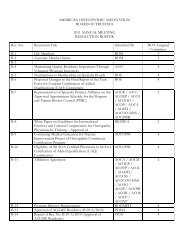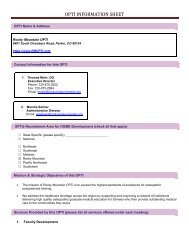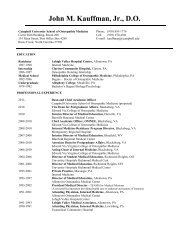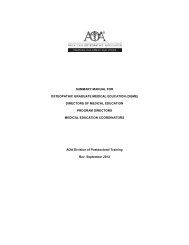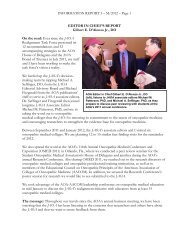Dialogue and Diagnosis - American Osteopathic Association
Dialogue and Diagnosis - American Osteopathic Association
Dialogue and Diagnosis - American Osteopathic Association
Create successful ePaper yourself
Turn your PDF publications into a flip-book with our unique Google optimized e-Paper software.
<strong>Dialogue</strong><br />
<strong>and</strong><br />
<strong>Diagnosis</strong><br />
142 E Ontario St, Chicago, IL 60611-2864<br />
ADDRESS SERVICE REQUESTED<br />
Non-profit St<strong>and</strong>ard<br />
U.S. Postage<br />
Paid<br />
Lebanon Junction, KY 40150<br />
Permit #69<br />
TAKE 10<br />
When it comes to injectable<br />
treatments for patients with type 2<br />
diabetes, here are 10 points to<br />
consider:<br />
1. Despite the wide range of<br />
medications to address the multiple<br />
pathophysiologic defects in T2DM,<br />
nearly 50% of people with diabetes<br />
mellitus have poor control of their<br />
disease.<br />
2. Patients failing to initiate prescribed<br />
insulin therapy commonly have<br />
misconceptions regarding insulin<br />
risk.<br />
3. A physician’s attitudes, beliefs , <strong>and</strong><br />
knowledge about diabetes mellitus<br />
can influence disease management.<br />
Suspicion about the safety <strong>and</strong><br />
efficacy of current treatments may<br />
be a barrier to aggressive manage -<br />
ment. Insulin should be offered to<br />
patients in a positive light as a<br />
means to improve their health.<br />
Reminding them early in the in the<br />
disease that there may be times<br />
insulin is needed in a pinch, such as<br />
a critical illness or hospitalization,<br />
may help.<br />
4. Because T2DM is a progressive<br />
disease, many patients will ultimately<br />
need insulin therapy to achieve <strong>and</strong><br />
maintain adequate glycemic control.<br />
Patients with T2DM, because of an<br />
innate insulin resistance, tend to<br />
require higher doses of insulin than<br />
patient with type 1 diabetes mellitus.<br />
5. Regarding glucose self-monitoring,<br />
physicians should consider urging<br />
measurements of fasting levels<br />
<strong>and</strong> “bracketing” 1 meal with<br />
prepr<strong>and</strong>ial <strong>and</strong> postpr<strong>and</strong>ial<br />
measurements daily on a repetitive<br />
basis.<br />
6. When choosing the treatment option<br />
for each patient, consider the<br />
durations of T2DM, stage of the<br />
disease, current level of control,<br />
lifestyle habits, <strong>and</strong> attitude toward<br />
disease management.<br />
7. Today’s physicians are faced with<br />
many more treatment options <strong>and</strong><br />
many more safety, efficacy, <strong>and</strong><br />
tolerability issues to consider then<br />
personalizing treatment for patients<br />
who require combination therapy in<br />
addition to metformin as T2DM<br />
progresses.<br />
8. Metformin has become the<br />
cornerstone of therapy on the basis<br />
of its efficacy, low risk of hypo -<br />
glycemia, low risk of weight gain,<br />
<strong>and</strong> generic availability.<br />
9. Ongoing therapeutic lifestyle<br />
management should be discussed<br />
with all patients with diabetes<br />
mellitus throughout their lives.<br />
Medical nutritional therapy must be<br />
individualized, generally requiring<br />
evaluation <strong>and</strong> teaching by a<br />
trained nutritionist/registered<br />
dietician or a knowledgeable<br />
physician. Lifestyle intervention<br />
remains the foundation of care of all<br />
patients with diabetes mellitus, <strong>and</strong><br />
healthy lifestyle choices should be<br />
addressed at every office visit.<br />
10. If an incretin-based medication is<br />
selected it is important to review<br />
the safety issues with the patient.



